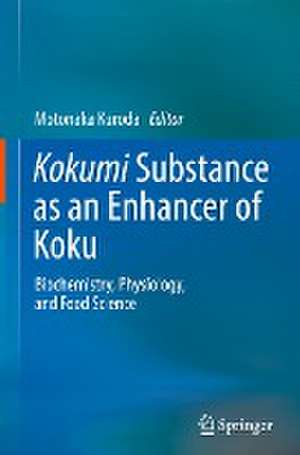Kokumi Substance as an Enhancer of Koku: Biochemistry, Physiology, and Food Science
Editat de Motonaka Kurodaen Limba Engleză Hardback – 20 feb 2024
This book provides the basic concepts and latest findings on kokumi substances. It covers not only the topics related to food chemistry, but also the biochemical and physiological mechanisms of the perception of kokumi substances.
Food palatability is determined by many factors, including taste, aroma, texture, color, physiological condition, and circumstances. The attribute called “koku” is used in Japan to express delicious foods. The definition of koku attribute was previously proposed to be caused by the sensation of richness, body, lingering (continuity), and mouthfulness in terms of taste, aroma, and texture. Kokumi substance is one of the taste-related koku enhancers and is defined as a substance that enhances complexity, richness (body), and lastingness (continuity), although it has no taste itself at the dose.
The topics in this book cover physiological studies, including the receptor mechanism, taste nerve recording, and human brain responses using functional MRI. It also discusses the sensory characteristics of kokumi substances when added to foods and the effect of kokumi substances on the satiety. The intended readers are university students, researchers and technologists in food science, food chemistry, nutritional sciences, taste physiology, and neuroscience. Non-expert readers interested in food palatability and the deliciousness of foods may also find this book useful. Preț: 1007.35 lei
Preț vechi: 1228.47 lei
-18% Nou
Puncte Express: 1511
Preț estimativ în valută:
192.78€ • 201.01$ • 160.22£
192.78€ • 201.01$ • 160.22£
Carte disponibilă
Livrare economică 27 februarie-13 martie
Preluare comenzi: 021 569.72.76
Specificații
ISBN-13: 9789819983025
ISBN-10: 9819983029
Pagini: 296
Ilustrații: X, 296 p. 1 illus.
Dimensiuni: 155 x 235 mm
Greutate: 0.66 kg
Ediția:1st ed. 2024
Editura: Springer Nature Singapore
Colecția Springer
Locul publicării:Singapore, Singapore
ISBN-10: 9819983029
Pagini: 296
Ilustrații: X, 296 p. 1 illus.
Dimensiuni: 155 x 235 mm
Greutate: 0.66 kg
Ediția:1st ed. 2024
Editura: Springer Nature Singapore
Colecția Springer
Locul publicării:Singapore, Singapore
Cuprins
Chapter 1. Koku Perception and Kokumi Substances.- Chapter 2. Kokumi substance as an enhancer of koku: its definition.- Chapter 3. Biochemical studies on kokumi γ-glutamyl peptides.- Chapter 4. Kokumi substances from garlic; Discovery of glutathione (GSH; γ-Glu-Cys-Gly) as a kokumi substance.- Chapter 5. Kokumi substances in soybean seeds.- Chapter 6. Kokumi substances in Thai-fermented freshwater fish, ‘Pla-ra’.- Chapter 7. Identification and quantification of the kokumi peptide, γ-Glu-Val-Gly, in foods.- Chapter 8. Mechanism for perceiving kokumi substances: Involvement of calcium-sensing receptor (CaSR) in the perception of kokumi substances.- Chapter 9. Molecular mechanism of enhancement in basic tastes by kokumi substances: A potent calcium-sensing receptor (CaSR) agonist, g-glutamyl-valinyl-glycine, amplifies sweet-induced ATP secretion via cell-to-cell communication in a mouse taste bud.- Chapter 10. Enhancement of Combined Umami and Salty Taste by Glutathione in the HumanTongue and Brain.- Chapter 11. γ-Glutamyl-valyl-glycine (γ-Glu-Val-Gly) and glutathione (γ-Glu-Cys-Gly) as kokumi substances in rodents.- Chapter 12. Effects of the potent kokumi peptide, γ-glutamyl-valyl-glycine, on sensory characteristics of foods and beverages.- Chapter 13. Perceptual and nutritional impact of kokumi compounds.- Chapter 14. Amino acids, α-peptides, and their related kokumi substances.- Chapter 15. Biochemical studies on lipid-related kokumi substances.- Chapter 16. Involvement of GPR120 in perception of fatty oral sensations in humans.- Chapter 17. Overview and future prospectives of studies on kokumi substances.
Notă biografică
Motonaka Kuroda has been a Corporate Fellow at Institute of Food Sciences & Technologies, Ajinomoto Co., Inc., Japan, since 2021. His research interests include sensory science, molecular mechanism and food chemistry of flavor substances. He has been a member of board of delegates at Japan Society for Bioscience, Biotechnology, and Agrochemistry since 2018, and a councilor of Japanese Association for the Study of Taste and Smell since 2019.
Textul de pe ultima copertă
This book provides the basic concepts and latest findings on kokumi substances. It covers not only the topics related to food chemistry, but also the biochemical and physiological mechanisms of the perception of kokumi substances.
Food palatability is determined by many factors, including taste, aroma, texture, color, physiological condition, and circumstances. The attribute called “koku” is used in Japan to express delicious foods. The definition of koku attribute was previously proposed to be caused by the sensation of richness, body, lingering (continuity), and mouthfulness in terms of taste, aroma, and texture. Kokumi substance is one of the taste-related koku enhancers and is defined as a substance that enhances complexity, richness (body), and lastingness (continuity), although it has no taste itself at the dose.
The topics in this book cover physiological studies, including the receptor mechanism, taste nerve recording, and human brain responses using functional MRI. It also discusses the sensory characteristics of kokumi substances when added to foods and the effect of kokumi substances on the satiety. The intended readers are university students, researchers and technologists in food science, food chemistry, nutritional sciences, taste physiology, and neuroscience. Non-expert readers interested in food palatability and the deliciousness of foods may also find this book useful.
The topics in this book cover physiological studies, including the receptor mechanism, taste nerve recording, and human brain responses using functional MRI. It also discusses the sensory characteristics of kokumi substances when added to foods and the effect of kokumi substances on the satiety. The intended readers are university students, researchers and technologists in food science, food chemistry, nutritional sciences, taste physiology, and neuroscience. Non-expert readers interested in food palatability and the deliciousness of foods may also find this book useful.
Caracteristici
Introduces the basic concepts and latest findings on kokumi substances Describes kokumi substances from biochemistry, physiology, food science, and sensory science perspectives Examines the biochemical and physiological mechanisms of the perception of kokumi substances
